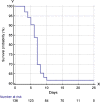Acute thrombosis of the lower limb arteries on the background of the XBB.1.5 ("Kraken") subvariant of omicron SARS-COV-2 - medical or surgical treatment?
- PMID: 37885941
- PMCID: PMC10597904
- DOI: 10.1007/s12055-023-01551-2
Acute thrombosis of the lower limb arteries on the background of the XBB.1.5 ("Kraken") subvariant of omicron SARS-COV-2 - medical or surgical treatment?
Abstract
Aim: Comparative analysis of the results of open thrombectomy and conservative therapy in patients with acute thrombosis of the lower limb arteries against the background of the XBB.1.5 ("Kraken") subvariant of Omicron Severe acute respiratory syndrome-related coronavirus-2 (Sars-cov-2).
Material and methods: The present prospective, open, multicenter comparative study for the period 04/01/2022 to 12/01/2023 included 167 patients with acute thrombosis of the lower limb arteries against the background of the XBB.1.5 ("Kraken") subvariant of the XBB.1.5 ("Kraken") subvariant of Omicron Sars-cov-2.Depending on the treatment strategy, two groups were formed: group 1 - open thrombectomy (n = 136) and drug treatment with an anticoagulant (unfractionated heparin in a therapeutic dosage) and an antiplatelet (acetylsalicylic acid 125 mg once a day); group 2 - only drug therapy (n = 31). This group consisted of patients who refused surgical revascularization and were on a prophylactic dose of unfractionated heparin (5000 U 3 times a day subcutaneously). On the development of acute arterial thrombosis, 80 U/kg (maximum 5000 U) of unfractionated heparin was injected intravenously in a bolus, followed by transfer to intravenous infusion using an infusion pump with an initial rate of 18 U/kg per hour under control of activated partial thromboplastin time. Analgesic and antiplatelet therapy was also prescribed (acetylsalicylic acid 125 mg once a day).
Results: No significant intergroup differences either in mortality rates (group 1: n = 58, 38.2%; group 2: n = 7, 22.6%; p = 0.09) or limb amputation (group 1: n = 63, 46.3%; group 2: n = 9, 29.0%; p = 0.07) were found. However, there was a trend towards a decrease in the incidence of these events in the drug treatment group. After open thrombectomy, rethrombosis developed in 50.7% (n = 69) cases; and thrombosis after rethrombectomy followed by amputation in 46.3% (n = 63). There were no hemorrhagic complications in both groups. Myocardial infarction and ischemic strokes were not recorded.
Conclusion: Anticoagulant therapy demonstrates several advantages over aggressive surgical management. However, probably due to the small size of the studied sample, significant differences were not obtained. Further study of this issue is required with the identification of the optimal reperfusion method in this complex cohort of patients.
Keywords: Acetylsalicylic acid; Amputation; Anticoagulant therapy; COVID-19; Coronavirus; Drug treatment; Novel coronavirus infection; Pandemic; Rethrombectomy; SARS-CoV-2; Thrombectomy; Thrombosis; Unfractionated heparin.
© Indian Association of Cardiovascular-Thoracic Surgeons 2023. Springer Nature or its licensor (e.g. a society or other partner) holds exclusive rights to this article under a publishing agreement with the author(s) or other rightsholder(s); author self-archiving of the accepted manuscript version of this article is solely governed by the terms of such publishing agreement and applicable law.
Conflict of interest statement
Conflict of interestThe authors declare no conflict of interest.
Figures
References
-
- Kazantsev AN. Thrombectomy vs conservative treatment in patients with COVID-19. Cardiovasc Ther Prev. 2021;20:2931. doi: 10.15829/1728-8800-2021-2931. - DOI
-
- Kazantsev AN, Chernykh KP, Bagdavadze GSh, Zarkua NE, Kalinin EYu, Artyukhov SV, et al. Express-isolation of the popliteal artery according to A. N. Kazantsev in acute thrombosis against the background of the course of COVID-19. Russ J Cardiol. 2021;26:113–120. doi: 10.15829/1560-4071-2021-4413. - DOI
-
- Kazantsev AN, Artyukhov SV, Chernykh KP, Shabaev AR, Bagdavadze GSh, Chikin AE et al. Emergency carotid endarterectomy for internal carotid artery thrombosis in the presence of COVID-19. Journal them. N.V. Sklifosovsky Emergency Medical Care. 2021; 10: 477–483. (In Russ.) 10.23934/2223-9022-2021-10-3-477-483.
LinkOut - more resources
Full Text Sources
Miscellaneous


